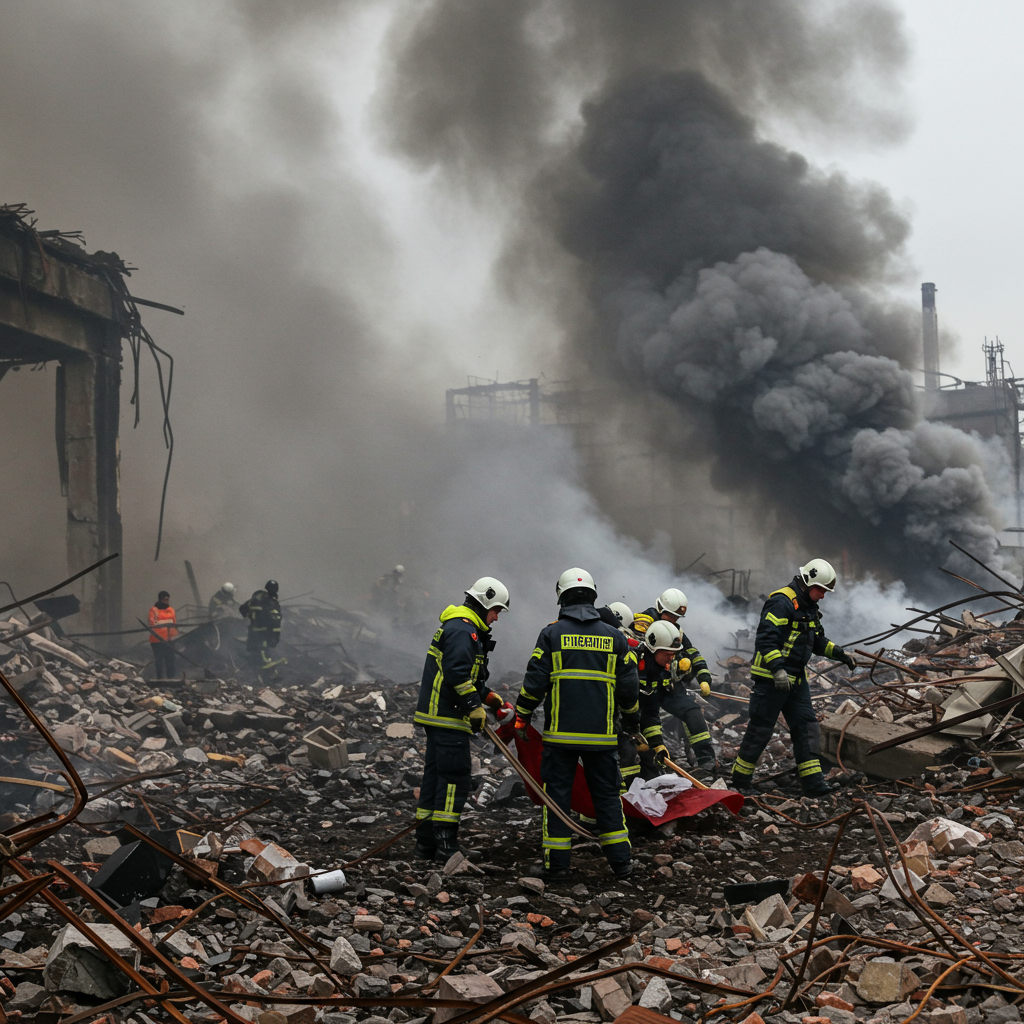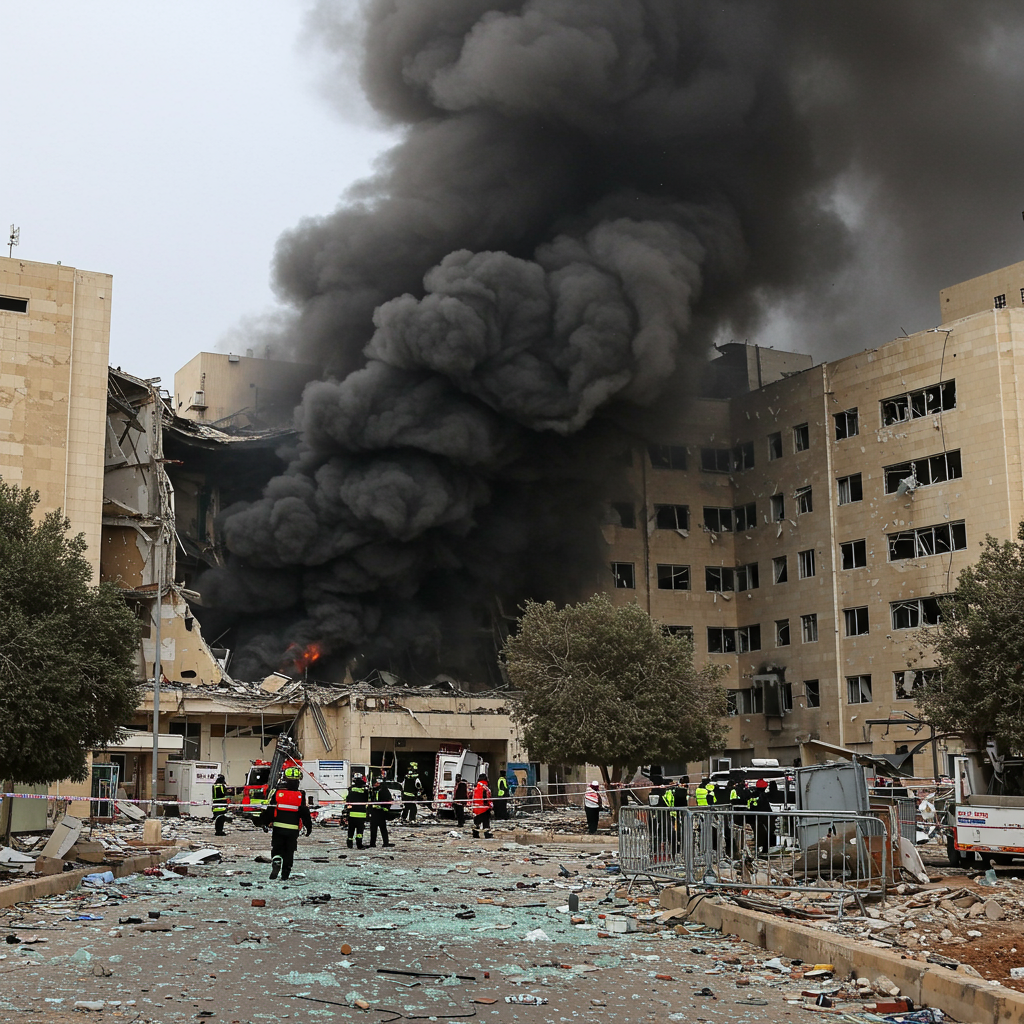A devastating industrial accident at an Elastik plant in Russia’s Ryazan region has resulted in a significant loss of life, shining a grim spotlight on persistent industrial safety challenges. The tragic Russia factory explosion, which occurred last week, claimed the lives of 24 individuals and left over 150 injured, underscoring the severe human cost when safety protocols falter. Emergency crews continue to sift through the extensive debris, while authorities launch a comprehensive investigation into the precise cause of the blast. This incident, unfolding approximately 155 miles southeast of Moscow, has sent ripples of grief and concern across the region.
The Catastrophic Blast at Elastik Plant
The catastrophic event struck the Elastik industrial plant, located in the Shilovsky district of Russia’s Ryazan region, on a Friday. What began as a fire quickly escalated into a powerful explosion, tearing through the facility. Official reports on Monday, August 18, 2025, confirmed the escalating casualty figures: 24 people dead and at least 157 injured. The sheer scale of destruction is evident in images released by authorities, depicting vast sections of the industrial complex, including entire factory halls, reduced to little more than rubble.
Search and rescue operations have been relentless since the initial blast, with emergency personnel working tirelessly to locate victims amidst the mangled remains of the building. The profound impact on the local community is palpable, as families grapple with unimaginable loss and the injured receive critical medical care. This deadly blast highlights the inherent dangers within certain industrial environments, especially when safety measures are compromised.
Unraveling the Potential Causes
Investigators are now meticulously working to determine the precise cause of the explosion. Initial reports from Russia’s state news agency RIA Novosti suggest that a fire ignited within a gunpowder workshop at the Elastik facility, subsequently triggering the devastating blast. The presence of highly volatile materials in such a workshop naturally raises questions about storage, handling, and fire prevention protocols.
Adding another layer of complexity to the ongoing inquiry, the 112 Telegram channel, known for its connections to law enforcement sources, floated an alternative theory. This channel alleged that the explosion might have been set off by a “rogue shell detonation.” While both possibilities are under consideration, the focus of the official investigation has shifted towards internal safety breaches.
Criminal Probe Points to Internal Failures
Crucially, Russia’s main investigative body has initiated a criminal case specifically into the violation of industrial safety rules at the Elastik plant. This particular course of action is highly significant. In the current geopolitical climate, with Kyiv having conducted sabotage attacks on Russian industrial and infrastructural targets since the 2022 invasion, there might be speculation about external involvement. However, by opening a criminal case focused on internal safety failings, authorities are implicitly indicating that they do not believe the Ryazan plant incident was caused by a Ukrainian attack. This distinction channels the investigation towards systemic issues within the plant’s operations rather than external aggression.
The emphasis on industrial safety violations suggests a deep-seated problem. It points to potential negligence, inadequate maintenance, or a failure to adhere to established safety protocols that could have prevented such a catastrophic event. This legal path underscores accountability within the facility itself.
A Tragic History of Safety Lapses
Tragically, this isn’t the first time the Elastik plant has been the site of a deadly incident. The facility has a disturbing history of accidents that underscore a pattern of safety failures. In 2021, the very same plant experienced another fatal explosion, claiming the lives of 17 people. Following that previous disaster, some of the plant’s management were found culpable and received prison sentences. This earlier conviction highlights a recurring problem of compliance and management oversight at this specific site.
Adding further weight to the concerns, it has been revealed that the Elastik factory had received multiple warnings from authorities regarding labor safety issues even before this latest incident. Such prior warnings, combined with the plant’s grim history, paint a concerning picture of persistent disregard for worker safety. This pattern is not isolated; fatal factory accidents are unfortunately a common occurrence across Russia, often attributed to chronic safety violations and systemic mismanagement within its industrial sector. These incidents highlight a broader challenge in enforcing robust safety regulations and ensuring accountability in high-risk environments.
The Human Cost and Community Impact
In the immediate aftermath of the Russia factory explosion, local authorities in Ryazan declared Monday a day of mourning. This official recognition of the tragedy reflects the deep sorrow and impact felt by the community. Beyond the official casualty count, the incident leaves behind a trail of grief, trauma, and economic disruption. Families are left to mourn loved ones, while survivors face long roads to recovery from their injuries.
Emergency services, including medical professionals and search and rescue teams, have demonstrated immense courage and dedication. Their efforts in the face of such devastation are critical to minimizing further loss of life and providing immediate aid. The long-term consequences of this disaster will extend beyond the immediate human cost, potentially impacting the region’s industrial output, local economy, and public trust in industrial safety standards. It serves as a stark reminder of the paramount importance of prioritizing human lives over production targets.
Ensuring Industrial Safety: Lessons from Ryazan
The recurring nature of industrial accidents, particularly at facilities like the Elastik plant, necessitates a critical examination of industrial safety standards and their enforcement. Robust regulations are only as effective as their implementation and oversight. This tragic event in Ryazan underscores the vital need for:
Proactive Risk Assessment: Regular and thorough evaluations of potential hazards.
Strict Compliance: Adherence to all safety protocols and national regulations.
Effective Enforcement: Rigorous inspections and significant penalties for violations.
Accountability: Holding management and relevant authorities responsible for lapses.
- Continuous Training: Ensuring all workers are educated on safety procedures.
- www.cbsnews.com
- www.yahoo.com
- www.newsday.com
- www.news18.com
- www.nbcnews.com
Learning from incidents like the Ryazan plant incident is crucial not just for Russia, but for industrial nations globally. The focus must shift from reactive responses to proactive prevention, ensuring that the safety of human lives remains the absolute highest priority in all industrial operations.
Frequently Asked Questions
What was the primary cause of the recent Russia factory explosion in Ryazan?
The recent Russia factory explosion that occurred last week at the Elastik plant in the Ryazan region is under investigation, with state news agency RIA Novosti reporting that a fire in a gunpowder workshop triggered the blast. The 112 Telegram channel also suggested a “rogue shell detonation.” However, Russia’s main investigative body has opened a criminal case into violations of industrial safety rules, indicating that internal safety failures are the primary focus of the inquiry, rather than an external attack.
Where exactly is the Elastik plant located, and what is its history of incidents?
The Elastik plant is located in the Shilovsky district of Russia’s Ryazan region, approximately 155 miles southeast of Moscow. This facility has a concerning history of accidents. Most notably, a deadly explosion occurred at the same plant in 2021, resulting in 17 fatalities. Following that incident, some of the plant’s management were imprisoned. Furthermore, the factory had reportedly received multiple warnings from authorities regarding labor safety violations prior to the most recent catastrophic event.
What systemic issues contribute to recurring industrial accidents in Russia?
Recurring industrial accidents in Russia, including the recent deadly blast at the Elastik plant, are frequently attributed to systemic issues such as chronic safety violations and widespread mismanagement within industrial facilities. Despite prior incidents and official warnings, adherence to safety protocols often appears to be lax. These persistent problems suggest deficiencies in regulatory enforcement, insufficient investment in safety infrastructure, and a potential lack of accountability for those responsible for maintaining safe working environments.
The tragic explosion at the Elastik plant serves as a stark reminder of the critical importance of robust industrial safety measures and unwavering accountability. With 24 lives lost and many more injured, the human cost is immense. The ongoing investigation, focused on internal safety violations rather than external factors, points to deep-seated issues that require urgent and comprehensive reform. Moving forward, prioritizing worker safety and implementing stringent oversight will be essential to prevent similar devastating incidents in the future and safeguard the lives of those who work in high-risk industries.




